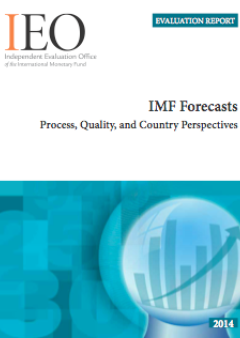
IMF Forecasts: Process, Quality, and Country Perspectives
Macroeconomic forecasts are important inputs into IMF bilateral and multilateral surveillance. They form the basis of the analysis and advice contained in Article IV consultations and of the Fund's view of the outlook for the world economy, as presented in the flagship publications: the World Economic Outlook (WEO), the Global Financial Stability Report (GFSR), and the Fiscal Monitor. The IMF also uses macroeconomic forecasts extensively in other contexts, such as debt sustainability analysis, spillover reports, pilot external balance assessments, and negotiations of IMF-supported adjustment programs, and as the baseline for constructing scenarios and risk assessments for the global economy.
For member country officials to have confidence in the IMF's analysis and advice, the underlying forecasts must be viewed as sound, evenhanded, and of high quality.
This evaluation assesses these aspects of IMF forecasts. Though the forecasting process at the IMF has evolved significantly in the past five years the assessment deals with current practice. It finds that:
- The processes and methods used to generate short-term forecasts for Article IV consultations and the WEO are well structured and, in general, appropriately tailored to country-specific characteristics. By and large, country officials have confidence in their integrity. Some officials believe the forecasting process lacks transparency, however—which is consistent with the evaluation team having to spend considerable time and effort to determine exactly how it is structured.
- Averaged over all member countries and over the period 1990–2011, WEO short-term and medium-term forecasts overpredicted GDP growth and underpredicted inflation. Measured biases in IMF forecasts are highly dependent on the chosen sample period, however. In particular, significant overpredictions of GDP growth tended to occur during regional or global recessions, as well as during crises in individual countries. Except for these episodes, the forecasts did not show substantial positive or negative biases.
- The accuracy of IMF short-term forecasts was comparable to that of private sector forecasts. This was the case for normal periods as well as for recessions and crises, and for advanced as well as emerging economies.
- Short-term forecasts of GDP growth and inflation made in the context of IMF-supported programs were unbiased in the majority of cases. However, they tended to be optimistic in high-profile cases characterized by exceptional access to IMF resources; these cases represented over eighty percent of the dollar amount of IMF resources disbursed. At the first program review (normally about three months into the program), forecast biases were typically reduced or reversed.
- The IMF has procedures in place to learn from past forecast performance, but these procedures are not always utilized to their full potential.
Changes in the world economy call for continuous adaptation of the forecasting process and learning by individual forecasters. The evaluation identifies areas where action can be taken to enhance the credibility of the forecasting process and to ensure that high quality is maintained. The recommendations of the evaluation fall into three broad categories. The IMF should:
- Promote a culture of learning from past forecast performance by introducing a more structured process for implementing and disseminating the recommendations of commissioned studies of forecast performance, and by ensuring that the accumulated knowledge and experience in the institution is effectively incorporated into the forecasting process.
- Ensure that best practice is followed by providing appropriate guidance to desk economists in forecasting for both the short- and medium term. Attention should focus on how forecast methods should be adapted to economies with different structural features and data availability. The IMF should monitor the consistency of medium-term forecasts across the institution as it does now for the short-term outlook.
- Enhance transparency by describing the forecasting process in an accessible form, and by making historical forecasts more easily accessible.
